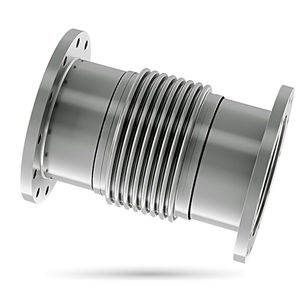
- Products
- Catalogs
- News & Trends
- Exhibitions
Metal pipe expansion joint BM-PB-IN LINE roundflangeaxial

Add to favorites
Compare this product
Characteristics
- Material
- metal
- Configuration
- round
- Installation system
- flange
- Expansion axis
- axial
Description
This expansion joint is designed to absorb axial and lateral movements while retaining the force of the pressure. The basic principle behind this type of expansion joint is the use of a compensation bellows along with two line bellows, connected by control rods, to balance the force of the pressure. The force of the pressure acting upon the line bellows is balanced against the force on the compensation bellows through the control rods. The purpose of this type of expansion joint is to support and balance the force of the pressure, in a manner such that fixed anchoring is not necessary in the pipe system, and so that the forces and movements exerted on the flanges with the delicate equipment connected are reduced to tolerable levels.
Characteristics and properties
Depending upon the design, absorb axial movements, lateral movements, or a combination of both.
Retains the pressure in both directions.
Does not require fixed anchoring, since the forces of the pressure are balanced.
Requires a minimum number of guides.
Transfers minimum loads to the equipment connected.
These are used when it is necessary to absorb axial and lateral movements, but where there is no space to install anchoring, or where such installation would be very costly.
Exhibitions
Meet this supplier at the following exhibition(s):


Related Searches
- Pipe expansion joint
- Round pipe expansion joint
- Flange pipe expansion joint
- Rubber pipe expansion joint
- Metal pipe expansion joint
- Weld-on pipe expansion joint
- Axial pipe expansion joint
- Pipe pipe expansion joint
- Canvas pipe expansion joint
- Pump pipe expansion joint
- Universal pipe expansion joint
- Gas pipe expansion joint
- Pipe expansion joint for the chemical industry
- Rectangular pipe expansion joint
- Dismantling joint
- Air conditioning pipe expansion joint
- Double pipe expansion joint
- ATEX pipe expansion joint
- Belt pipe expansion joint
- Construction pipe expansion joint
*Prices are pre-tax. They exclude delivery charges and customs duties and do not include additional charges for installation or activation options. Prices are indicative only and may vary by country, with changes to the cost of raw materials and exchange rates.

















